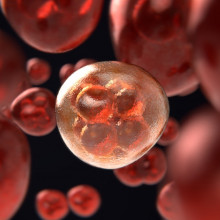King Charles' cancer, and a new particle supercollider
In this edition of The Naked Scientists: Why cancer waiting lists have lengthened, and the importance of catching the disease early; how pollution is blinding insects to plants they might otherwise want to pollinate: and how do blueberries come by their colour? It’s not as simple as it sounds: squash one and you’ll see they’re not blue inside!
In this episode

00:60 - King Charles' cancer diagnosis causes uptick in GP visits
King Charles' cancer diagnosis causes uptick in GP visits
Naser Turabi, Cancer Research UK
It was announced this week that King Charles III is stepping back from his Royal duties as he undergoes treatment for cancer. It has not been disclosed what type of cancer Charles has, but it was discovered when he was being treated in hospital for an enlarged prostate. Meanwhile, BBC News analysis has revealed that cancer waiting times for 2023 in England were the worst on record. Naser Turabi is director of evidence and implementation at Cancer Research UK...
Naser - At the moment in the UK the results have just come out. For the last year, for 2023, about 65% of people have met the target, which is to wait about two months from urgent referral to their treatment. The target is actually 85%, so that means 20 percentage points off that. And what that means is that obviously people are waiting too long for treatment, but the longer you wait for treatment and the later a cancer is diagnosed, the more likely it is to progress, and the further a cancer progresses, the harder it is to treat. So what we find, for example, in bowel cancer is that cancer is detected at an early stage, 95% of people survive for at least five years, but if cancer is detected at a late stage when it's spread to other parts of the body, only about 15% of people survive five years.
Chris - So the early bird catches the worm, it really matters here, doesn't it? Those numbers that you are citing in terms of the wait times, they have crept up inexorably year on year. Why is that? Why are we waiting longer?
Naser - Yes, you are right. We haven't met that target since about 2015. And the main reason we haven't is because the NHS doesn't have enough capacity to do the diagnostic tests and to do the treatment that's required. Investment in diagnostics - that means scanners, that means radiologists who interpret the scans, that means pathologists who diagnosed the tissue samples, oncologists and surgeons. We don't have enough of those essentially. And it takes a long time to train those people and we haven't invested enough over the last 10 or 15 years in doing that. But what we actually are also seeing is that we have an ageing population and that cancer is in fact predominantly a disease of older people. So there are much higher numbers of people aged over 70 and the shape of our population is changing over time and we have a much older population than we did even just 10 years ago and so the demand is increasing. We've got about 30% more urgent cancer referrals than we did in 2019. So we're seeing an increase in demand, but not enough increase in NHS capacity.
Chris - Has that bulge in terms of an ageing population also changed the types of cancer that people are presenting with? Historically, we thought about prostate cancer in men, lung cancer overall across the population, bowel cancer, bladder cancer, as very common cancers. Are we seeing that distribution change because the population's ageing or, we just got more of it?
Naser - I think generally we're just getting more of the same cancers. What we are seeing, and it's positive, is increasing early stage diagnosis for some cancers, particularly the ones where we've got screening programs in place. So for bowel cancer, for cervical cancer and for breast cancer, those screening programs are really successful at finding early stage cancers. And similarly for cervical cancer, what we're actually seeing is the HPV vaccine, is having the effect to prevent cancer. So younger people, fewer younger people are getting cervical cancer.
Chris - And in terms of what's happened with King Charles, when a high profile person goes public with a diagnosis like this, does that make a difference? Do more people go and see doctors either with disease and get picked up earlier? Does it help and do you also see more worries? Well, so you've got a higher risk of saturating the system. There must be two sides to this coin.
Naser - So we absolutely do see an uptick in presentation by the public when celebrities go public on having cancer. So we saw that with Jade Goody for cervical cancer. We saw it with Stephen Fry for prostate cancer. We saw it for Angelina Jolie when she announced she was having a preventative mastectomy. Last year Dame Deborah James died, and that caused a big uptick in the level of bowel cancer referrals and broadly speaking, these are really positive. There is a small concern that you might stimulate people who are just worried, but often if you've got symptoms, you do need to go to your GP anyway. And so it's really about your GP, going to your GP, making sure they can make the decision. And the most important thing, and actually often the longest delay is when people are sitting at home with symptoms or received a screening invitation letter but haven't acted on it. So anything that helps people to seek help we think is positive.
Chris - Are there any MOT type tests that you would advocate if you are a man in his mid to late fifties for example, or a woman of a similar vintage, are there any things where you're thinking, I would advise those people if they can to go and get tested for the following things and does that have merit doing that?
Naser - Going and getting tested when you don't have symptoms of things is quite a complicated issue. And so what we would definitely recommend at Cancer Research UK is that if you are eligible for the national screening program, so bowel, cervical and breast, you absolutely should consider taking up that invitation. It's not compulsory, but you absolutely should consider that because those are very likely to find cancers at an early stage. Other than that, actually you should make sure that you are aware of the signs and symptoms of cancer. So that can be unexplained weight loss blood in your poo or urine, and there are many others and you should go to our website and check it out, all the NHS websites. But generally these sorts of general health mots aren't that helpful for cancer.

07:25 - European plans for a new supercharged particle accelerator
European plans for a new supercharged particle accelerator
Sarah Williams, University of Cambridge
It’s been ten years since the enigmatic particle referred to as the Higgs Boson was discovered at the Large Hadron Collider or LHC, which is based in a circular 27 kilometre long tunnel in Switzerland. By smashing together protons at close to the speed of light, it helped to confirm key theories conceived half a century ago about the particles that make up the Universe around us, but important gaps still remain. Now the team at CERN are envisaging an even bigger particle accelerator ten times as powerful and three times the size of the LHC. And it’s got a price tag to match. Sarah Williams is from the department of physics at the University of Cambridge...
Sarah - In a nutshell, what we would like to do is build a very large circular tunnel that would be around 90 kilometres in length that we would use for our next generation particle collider. The aim is that this would actually be kind of two colliders in one. We would first use the tunnel to house a collider that would collide electrons with their antiparticles, the positron, and this would be what we call the Higgs factory. So this would allow us to make very precise measurements of the Higgs Boson. This is the particle that we discovered at the LHC over 10 years ago now. But actually, although we discovered it, there's still lots we can learn about its properties and how it behaves with respect to other elementary particles. What we'd then do is upgrade this detector. We'd install a whole new accelerator, and we'd then use that to collide protons. So this would kind of be a bit like a super LHC. We'd be raising the energy and also allowing a lot more collisions. And in doing that we'd be really pushing our discovery reach for new particles. We could discover to the highest possible level based on current technologies. We'd be searching for particles that can explain dark matter. We'd also be aiming to discover processes in our current model that we haven't been able to observe before. The very particular measurements about the Higgs, including how it interacts with itself, could have some really big implications for our understanding of the history of the universe and cosmology.
Chris - This proposal would see something being created that's about three times bigger than what you've got already at CERN with the LHC. Why do you need a bigger accelerator to do these things?
Sarah - That's a really good question, and for anyone wanting an idea of scale, the length of this tunnel is around half the length of the M25 motorway. The reason we have to get a much bigger ring is that particles lose energy if you accelerate them around in a circle. So what that really means is to go to higher energy collisions, particularly for protons which are heavier than electrons. We need a really high ring. So the reason that we're scaling up the size of the ring is we want to scale the energy of the collisions, and that of course gives us the potential to discover more particles.
Chris - And how much energy can you harness and therefore endow these particles with when they're in this accelerator?
Sarah - Let's take the proton collider to begin with. The LHC at the moment is colliding protons at a centre of mass energy of 14 tera electron volts. So that actually seems quite big, but actually you have to remember that this is confined on a very small scale. So the energy in colliding protons in the LHC is actually roughly that of a flying mosquito. For the FCC, we'd be wanting to go to a hundred TV, so that's around a factor of 10 increase in energy. And what that means is it would also scale up the mass reach for the heaviest particles we could possibly discover.
Chris - What do you think is missing then? Where are the gaps that you want to probe with this? Because many physicists thought that with the discovery of the Higgs Boson, as you say 10 years ago, that we almost had a complete picture there. So where are the gaps?
Sarah - Probably that's a problem in the way we were advertising the discovery of the Higgs. Many people said that when we discovered the Higgs, we'd completed the standard model. The standard model is our model of what we think the basic building blocks of the universe are and how they interact with each other. The problem with that is that we know the standard model can't be a complete theory of everything. There are a few obvious gaps. One of them that people might have heard about is dark matter. This is something we know exists in the universe. We can see how it impacts the behaviour of galaxies and things based on its gravitational interactions. But we don't have a candidate in the standard model for what dark matter could be. So that's an obvious target for the future. Other things we'd like to target are, as I said earlier, very precise measurements of properties of the Higgs Boson, that could have important implications for how we understand why we live in a matter dominated universe today. Anyone that's read His Dark Materials might have come across the idea of antimatter. And of course the fact that we don't see antimatter everywhere in the universe tells us that there must be some small difference between matter and antimatter. That means that we live in a matter dominated universe today. And explaining how that happened and what these differences are is also something we're trying to do.
Chris - Not all scientists are supportive, though. The spend is quite big. It's getting close to $20 billion. The original LHC cost about $3 billion. So this is a big uptick in spend. People like Sir David King, the government's former chief scientist have said this is irresponsible at a time when we have effectively bigger fish to fry with that sort of money. What sort of a difference could this make if we do go down this path and should we go down this path? Why do we need to do this?
Sarah - I think there are a few things I'd like to say to that, and it's worth me declaring at this stage that I really do think this project is the best way forward for our field. Going to the price tag, I think it's worth realising that this will deliver half a century of science for our field, and it's spread out over a large number of cooperating countries over a long period of time. When we were building the International Space Station, the cost of the European contribution to that which was spread over 10 years, came out around 8 billion euros. And this is roughly the same magnitude of the price tag we're looking at for the tunnel for the FCC, Future Circular Collider. And at the time it was argued that this was around one Euro cup of coffee per person every year for the 30 years of which they'd been operating. In terms of whether or not the science is worth it, whilst there are other challenges going on in the world, we shouldn't cut down the importance of doing fundamental science. There are lots of really exciting spinoffs that come from technologies. I quite like the fact that some of the magnet technologies that are being considered for the FCC, these technologies are called high temperature superconductors, and these could also have applications in fusion technology, which is of course very relevant for trying to solve the energy crisis. In terms of the questions we could answer, we are really talking about pushing our understanding of the fundamental particles in the universe to a factor of 10 higher in precision, and raising the energy reach of what we could discover. And I think that's worth doing.

15:09 - Pollutants mask flower scents from pollinators
Pollutants mask flower scents from pollinators
Jeff Riffell & Joel Thornton, University of Washington
The relationship between plant and pollinator is a delicate one, forged over millions of years of evolution. In order to attract insects to spread their pollen, a lot of plants announce their existence by releasing their own particular smell. These smells are created by forming a cocktail of different chemicals. But now, scientists at the University of Washington have discovered that common, nitrogen-containing compounds in air pollution can attack these odours and mask the ability of plants to attract their key pollinators, denting plant productivity. The two leads of the study are Joel Thornton and Jeff Riffell…
Jeff - We were very interested in understanding how the atmospheric pollutant impacts animal behaviour. And we took advantage of this plant pollinator system, this primrose and its moth, to examine how air pollution could impact and affect the ability of these moths to pollinate their flowers.
Chris - Which pollutants were you looking at, Joel?
Joel - So we were specifically interested in pollutants that arise from nitrogen oxides, which are emitted by fuel combustion for transportation and energy production. These can get converted in the atmosphere through chemical reactions to highly reactive radical species, we call them. And the specific one we were targeting in this study was the nitrate radical. It's a nitrogen with three oxygens attached to it.
Chris - And Jeff, biologically speaking, what did you actually do when you were interested in studying this particular chemical? How were you applying that to this moth primrose story?
Jeff - So these flowers that are pollinated by moths, they open up at night. They emit a really high intensity scent to lure the moths from far away. And we actually discovered that some of these compounds, especially these monoterpenes in the floral scent, giving it this kind of piney odour, we're very sensitive to these atmospheric pollutants that are occurring, these nitrate radicals that are occurring in the environment.
Chris - Is the nitrate radical breaking down the scent molecules, Joel? Or is it affecting the ability of the moths to smell it?
Joel - Yeah, so it's affecting the ability of moths to smell it because it's breaking down the monoterpenes through reactions, changing it into slightly different shapes, slightly different elements as being part of the molecule that change the ability of the moths to actually detect and they don't recognise it as being part of a floral scent.
Chris - And what impact does this have on the rates of pollination, Jeff?
Jeff - So these moths require these infochemicals, these monoterpenes to locate these patches of flowers that can be quite distant, kilometres away from one another. And once they're degraded, the moss can no longer recognise the flowers at all. What we found is that both in the laboratory and in the field, their visitation to flowers decreased pretty dramatically, up to 70%. And this had a really strong effect on plant fitness. It impacted, we estimated, about 20% of their ability to produce fruits and seeds, for instance.
Chris - And were the levels at which this was happening relevant to what we see around the world, Joel?
Joel - Yes. That was one of our goals was to replicate as best we can the environment as it is today in terms of the types and amounts of pollutants that are interacting with the floral scents. So it's quite relevant to an urban area, say downwind. So it replicates a large number of areas around the world.
Chris - And Jeff, is this indicative of what's probably happening more broadly? Do more insects use more similar compounds like this and therefore they're likely to be falling victim to the same effect and therefore are more plants losing productivity because of this?
Jeff - The infochemicals that were really degraded by these pollutants are used in a variety of plant pollinator interactions, and they're also involved in a variety of other processes and occurrences like how insects find their host plants. And what we can think then is that, because these are kind of ubiquitous infochemicals, we really strongly believe that what we found in this one plant pollinator system could be generalisable to what's actually occurring worldwide.
Chris - I know we're talking here about effectively plant fertility, which is achieved through pollination, but could the same effects also impact the ability of insects to find their mates? Because insects do, like moths especially, track each other down using pheromone smells. Could they be attacked by atmospheric pollution in the same way and therefore we're also going to see a decimation potentially of insect populations?
Jeff - Yeah, these info chemicals, these airborne chemicals, are used by insects and animals in general for a variety of different processes like finding mates, finding prey, finding plants, and available plants to use for food. And so we just don't know enough about how the effects of these airborne pollutants could have on these other processes. And so this is an important topic that we need to study more.
Chris - So what's the take home message here, Joel?
Joel - Broadly speaking, it shows how deep the impacts of air pollution go into the Earth's systems. So for many years we have been worried about the effects of air pollution, rightly so on the quality of human life. And it's a negative health impact through long-term exposure. But in this study, we think it can be used as a way to extrapolate to other processes in ecosystems that depend on these info chemicals, where air pollution is sort of penetrating deep into the air system and impacting ecosystem functioning and agricultural productivity and food security through the negative effects it's having on pollinators in this way. And so it's really about the broader negative impacts of air pollution going beyond just what we can see and smell, say, in an urban area.

21:29 - Why blueberries are blue
Why blueberries are blue
Rox Middleton, University of Bristol
The blueberry has been a part of our diet for nearly 13,000 years, and for good reason. They’re high in vitamin C, high in antioxidants, and contain a good amount of fibre. But for all this time, the source of their iconic colour hasn’t been so clear. Until now. Researchers at the University of Bristol have discovered the secret behind this berry’s brilliant blue. The lead author on the paper is Rox Middleton…
Rox - I've been looking at some other blue fruits, which aren't blue because of pigment, but because of structures inside them. But then I suddenly realised that I didn't actually know how blueberries made their colour. I'm used to the idea that there might be really, really tiny structures that are causing the colour. And so initially when we started looking at the fruits, it was a case of rubbing them and realising that the colour was really carried by the waxy coating on the outside.
Chris - Is this the same science that explains why, for instance, butterfly wings look the colours that they are? It's the shapes of tiny structures on the surface of the wings that give them the colour, it's not because they've got pigments in them.
Rox - That's exactly right. This time the structures are really quite different to the way that butterflies do it. But it's exactly the same idea that there are small structures which interact directly with the light waves but don't absorb any of the light like a coloured pigment would do.
Chris - How did you do this then? How did you actually test that and prove that is what is going on? It's the stuff on the surface of the blueberry that's making it look blue.
Rox - Well, we did make a computer model and look at how that happened, but the other way of doing it was by removing that wax from fruits and then it's completely clear when it's a inner solution then letting that dry out and then re evaporating that wax onto the surface of a piece of black card and we got the blue colour back in that coating.
Chris - Why don't blueberries, if they want to be blue, why don't they just make a chemical that's blue rather than going to all the trouble of making some waxy stuff on their surface that makes them look blue?
Rox - The crazy thing is they do have pigments in them, which could be blue. So they are filled with anthocyanins and the anthocyanins are really important because they make the surface of the fruit look really dark. And without them being dark, you wouldn't be able to see the blue at all. Anthocyanins make fruits red and black, but they can also be blue. But it depends on having certain conditions inside the cell to make them blue. So it might be that it has to have a metal complex with the anthocyanins or you might have to have another really big molecule. And both those things are energetically expensive is what we say.
Chris - And so the fruit just made the choice to go down the route of adding another layer on the outside to make itself look blue, even though the stuff inside could be used for that purpose. It's easier to make a new chemical that it puts on the outside.
Rox - It seems like it, but in fact actually these coatings are on most surfaces of most land plants and they just normally don't make the plant look blue. They have loads of other functionalities, which might be another reason why it's good for the fruit to have that coating. And then a slight adaptation can make that into an also blue coating.
Chris - And what's the purpose of it? Does it have a role beyond changing the colour of the fruit? Is that its primary role or is it there to do other things and it just happens to have this bluing effect in the context of something that is dark?
Rox - Well, we don't know about the other effects. There’s still loads to discover about waxy coatings. What was kind of exciting was to find the same blue colour or you know, similar range of blue colours happening across loads and loads of different fruits. And we do know that it's important for fruits that they are highly visible to animals and birds that eat them. And we were able to look at how birds see things. So what the visual system of a bird does and see that this is really colourful to birds.
Chris - Yeah, because birds have got the ability to see a wider repertoire of colours than we can haven't they?
Rox - Certainly some do. There are lots of birds that don't see UV, but there are loads of birds that do see UV and then also red, green and blue.
Chris - So does this waxy coating work into the UV as well? It's not just the visual visible blues that we can see. Birds looking in the UV, are they going to see something different then in the UV with this wax coating?
Rox - So we know that they see UV and we know that they see blue, so they would see the two together.
Chris - There are multiple plants that have dark fruits that seem to deploy this strategy. Have they all arrived at this independently because it works or are they all in some way related distantly and they're getting it from one common ancestor?
Rox - I think it's a really interesting question. The thing is that they're very, very distantly related. Some of them aren't even angiosperms. They aren't even the flowering plants. So like pine trees. But then basically all of the land plants have this wax, but normally the wax is not blue.
Chris - Is there anything we can do - apart from it's academically very satisfying to be able to explain this, but is there anything we can do with it? Now we know they do this and we know how they do it and we know how it's working. Can we use it?
Rox - Yeah, potentially We could make coatings which have the same effect, which use the same structures and we could make them out of a different material or we could even use this material. Since it's a biological material, it's sustainable and it's often also a waste product. So maybe we could use that and it just self assembles to make these coatings itself. So we could perhaps use that as a colourant or a protective coating. Something that protects against UV perhaps.

27:08 - What did cavemen do for sex ed?
What did cavemen do for sex ed?
Thank you to UCL's Michael Reiss for the answer!
Michael - In many cultures, sex education has been undertaken outside of schools for as long as is known. Often near the time of puberty, girls and boys are separately initiated into adulthood. Girls are told about menstruation and sexual intercourse by their mothers or other adult females; boys are told about sexual intercourse by their fathers or other adult males.
With the increasing establishment of formal schooling over the last couple of hundred years, schools have often been expected to teach sex education. Precisely what the emphasis has been has varied greatly. For example, before the advent of antibiotics, a lot of emphasis was often placed on avoiding infection with gonorrhoea and syphilis. In the 1980s, the advent of HIV/AIDS meant that there was suddenly a shift towards teaching about HIV transmission and prevention. To this day, a frequent emphasis is on avoiding becoming a parent too early in life.
Surveys regularly show that parents support schools playing a role in sex education. Student evaluations frequently show that they aren’t very impressed with the sex education they receive in schools, reporting that their teachers are often embarrassed and not good at answering questions.
Related Content
- Previous Healing war wounds
- Next How much rainfall becomes groundwater?










Comments
Add a comment